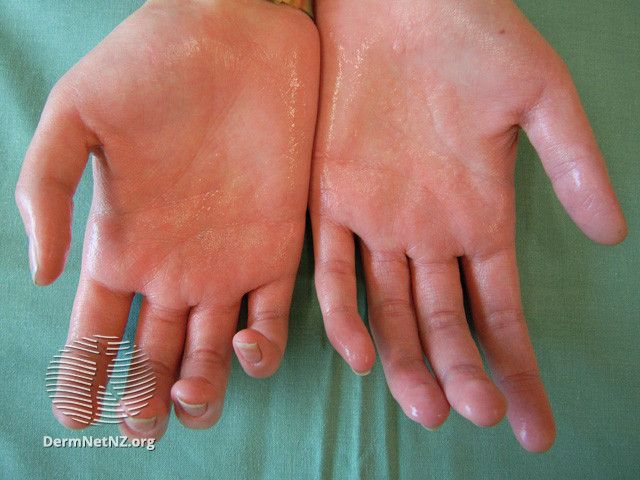- Acne
- Actinic Keratosis
- Aesthetics
- Alopecia
- Atopic Dermatitis
- Buy-and-Bill
- COVID-19
- Case-Based Roundtable
- Chronic Hand Eczema
- Drug Watch
- Eczema
- General Dermatology
- Hidradenitis Suppurativa
- Melasma
- NP and PA
- Pediatric Dermatology
- Pigmentary Disorders
- Practice Management
- Precision Medicine and Biologics
- Prurigo Nodularis
- Psoriasis
- Psoriatic Arthritis
- Rare Disease
- Rosacea
- Skin Cancer
- Vitiligo
- Wound Care
News
Article
Hyperhidrosis Disease Burden Requires Further Understanding
Author(s):
More understanding of the physical, psychological, and economic burdens of hyperhidrosis is needed.
Hyperhidrosis brings physical, psychological, and economic burdens, globally and in Japan, and understanding its nature and the economic and human burden it poses on patients is important, according to a review published in The Journal of Dermatology.1 The authors noted that this burden can affect patients’ quality of life and productivity.
Researchers conducted a targeted literature review (TLR) to gather existing evidence on the epidemiology and the human and economic burden posed on patients with hyperhidrosis. Hyperhidrosis is a chronic skin condition characterized by excessive sweating, and patients can incur costs that are associated with attempting to manage and hide excessive sweating, which can be embarrassing.
First, searches were performed in the MEDLINE and ICHUSHI databases. Articles published between January 2000 and September 2020 that evaluated at least 50 patients were included in the review. Then, a total of 64 publications were identified and 38 publications covering a unique domain were chosen to inform the TLR.
The incidence of hyperhidrosis fluctuated from 0.13% in the UK to 0.28% in the United States, with a higher rate in female patients. The prevalence ranged from 2.8% to 4.8% in the US general population to 18.4% in Chinese inpatients, whereas the prevalence of axillary hyperhidrosis ranged from 1.4% in the US general population to 5.75% in Japanese employees/students.
Because of excessive sweating, hyperhidrosis was noted to be a moderate to extreme limitation at work for the US patients, with 33.5% feeling unhappy. Post treatment, patient satisfaction was high. Sizeable costs were related to treatment with botulinum toxin and surgery. Hospital stays for surgery lasted from 10 hours to 3 days. Those patients who sought a medical consultation ranged from 6.3% for Japanese patients with primary focal hyperhidrosis to 51% for the US general population with any type of hyperhidrosis.
There was little evidence of the hyperhidrosis burden, especially among Japanese patients, but the burden was high and decreased patients’ daily functioning. Little evidence of the human burden was observed, which might be because of a low level of awareness among patients.
The cost of hospitalizations was found to be the highest in terms of economic burden of direct costs. Indirect costs are still not well understood, but despite this, 3 publications reported on productivity loss and the number of days prior to returning to work, which suggested that hyperhidrosis might have a negative social impact. Only 1 study on the costs of therapy was identified, showing that treatment costs decreased over time.
In general, a high level of patient satisfaction following surgeries or injections was reported, but no evidence was found for other treatments.
Researchers recommend that action should consist of implementation of educational programs to increase awareness of the condition, conduct of larger studies, and generation of more evidence.
Additionally, comprehensive understanding of the human burden of hyperhidrosis might be a possible area for further investigation in Japan as evidence from Japan is limited in size and scope of studied outcomes. The emergence of new topical anticholinergics is expected to improve the treatment landscape.
This is the first comprehensive TLR study on hyperhidrosis including the epidemiology and disease burden of hyperhidrosis throughout regions to date, the authors noted. However, it has some limitations. Because of the heterogeneity of populations analyzed in the included publications, descriptions, and comparisons of defined outcomes by studies throughout publications were challenging and could impact the generalizability of the findings. Also, this study covers literature published within a limited timeframe, and research needs to be updated for trends past September 2020.
“Future actions should include implementation of educational programs for physicians, medical specialists, and patients to raise awareness of the condition; the conduct of further studies with larger scope and bigger patient populations; and the generation of more evidence for Japan,” concluded the authors.
Reference
- Oshima Y, Fujimoto T, Nomoto M, Fukui J, Ikoma A. Hyperhidrosis: a targeted literature review of the disease burden. J Dermatol. Published online July 31, 2023. doi:10.1111/1346-8138.16908
[This article was originally published by our sister brand, AJMC.]
Newsletter
Like what you’re reading? Subscribe to Dermatology Times for weekly updates on therapies, innovations, and real-world practice tips.












